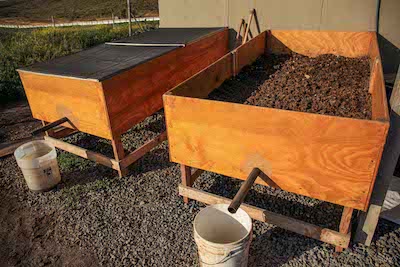Since the establishment of the agricultural production at Centro de Conferencias, staff at the farm have experimented with methods to produce more nutritious food without using toxic chemicals, while also building up a living soil with an increasing multitude of life forms.
In the beginning, soil improvement was based on recommendations from a soil laboratory: small amounts of minerals like boron, magnesium, iron, zinc, sulfur and copper were added, and agricultural lime and compost made from fish waste was applied.
Over the years, however, it became clear that the main precondition for organic agricultural production was to have the right microorganisms in the soil.
To this end, the farm’s staff has collaborated with two biologists from Ensenada for several years.
Experimenting with compost recipes
Soil organisms, which consist of bacteria, fungi, nematodes and worms, need food to multiply and provide benefits for the plants.
Fungi are good at extracting minerals from the soil particles and make these available for the plants in exchange for food. Some bacteria can capture nitrogen from the air and turn it into nutritious compounds that the plants can access.
These organisms need food, and that food is provided by compost.
The compost experiments carried out at the farm have investigated questions such as:
- Which local organic matter to use for the compost?
- How to prepare and mix these materials?
- How much compost to apply?
The biologists have followed the experiments by looking at the results in terms of vegetable production, studying the soil life through their microscopes and analyzing the data.
The current compost system
Currently, the compost ingredients used in the farm are:
- Manure from goats, chicken and cows
- Green leaves from the center garden
- Chopped dried plant parts, like agave and palm leaves
- Shredded paper
- Bio char – dust of charcoal made from wood waste
Most of the compost is mixed directly into the vegetable beds. A small part is used in a special tank to make compost tea, which is then added to the drip irrigation water.
Vermicompost is made by earthworms from vegetable and kitchen waste. The liquid dripping from this is also added to the drip irrigation water.
The compost systems have improved the life in the soils on the farm, and the biologists now record more fungi, which extract nutrients from the soil particles, and beneficial nematodes, which keep a healthy balance between the soil organisms.
The healthy life of diverse microorganisms in the soil reduces the effects of harmful organisms, strengthens the plants and contributes to healthier crops.


